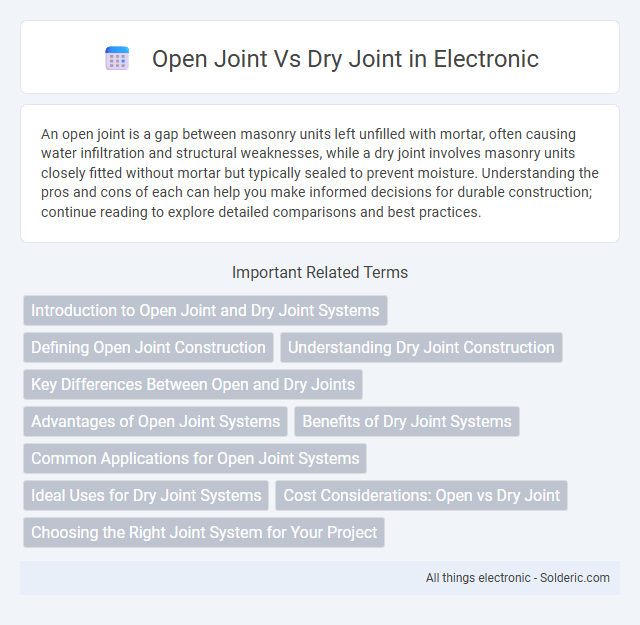An open joint is a gap between masonry units left unfilled with mortar, often causing water infiltration and structural weaknesses, while a dry joint involves masonry units closely fitted without mortar but typically sealed to prevent moisture. Understanding the pros and cons of each can help you make informed decisions for durable construction; continue reading to explore detailed comparisons and best practices.
Comparison Table
| Feature | Open Joint | Dry Joint |
|---|---|---|
| Definition | A joint where materials meet without sealing, allowing airflow or water passage. | A joint assembled without adhesive or mortar, relying on mechanical fit or friction. |
| Water Resistance | Low; prone to leakage unless specific drainage applied. | Minimal; not water-tight without additional sealing. |
| Airflow | Allows ventilation and drainage. | Limited airflow; tightly fitted but not sealed. |
| Common Uses | Cladding, facade ventilations, expansion joints. | Precast concrete elements, stone masonry, mechanical joints. |
| Installation | Simple placement with gaps maintained. | Precise fitting required; no bonding agents. |
| Durability | Depends on exposure and drainage design. | High mechanical strength if properly fitted. |
| Maintenance | May require cleaning to prevent debris blockage. | Low maintenance if stable; periodic inspection recommended. |
Introduction to Open Joint and Dry Joint Systems
Open joint systems feature intentionally spaced gaps between materials to allow for ventilation and water drainage, enhancing building envelope durability. Dry joint systems, characterized by tight, interlocking components without mortar or sealants, rely on mechanical fastening for structural integrity and ease of installation. Both systems optimize facade performance by addressing moisture management and thermal movement effectively.
Defining Open Joint Construction
Open joint construction refers to a building technique where gaps or spaces are intentionally left between cladding panels or other exterior materials to allow for ventilation and drainage. This method enhances moisture management by preventing water accumulation, reducing the risk of mold and structural damage. Open joint construction is often contrasted with dry joint systems, which rely on sealed connections to keep moisture out without venting.
Understanding Dry Joint Construction
Dry joint construction involves assembling components without using mortar, relying on precise fitting and mechanical connections to ensure stability and durability. This method contrasts with open joints, which incorporate intentional gaps for ventilation or expansion, often sealed differently. Understanding dry joint techniques is crucial for applications requiring rapid assembly, maintenance access, or flexibility in structural movement.
Key Differences Between Open and Dry Joints
Open joints have visible gaps and are often filled with sealant, while dry joints rely on tightly fitting materials without filler to create a barrier. Open joints allow for movement and ventilation but may require maintenance to prevent water infiltration, whereas dry joints provide a more rigid, moisture-resistant connection by utilizing precise craftsmanship. Your choice between open and dry joints affects durability, weather resistance, and flexibility in construction applications.
Advantages of Open Joint Systems
Open joint systems offer enhanced ventilation and natural drainage, reducing moisture buildup and extending the lifespan of building materials. These systems improve energy efficiency by allowing air circulation to regulate temperature and humidity. The design also facilitates easy maintenance and repair, minimizing long-term costs.
Benefits of Dry Joint Systems
Dry joint systems offer enhanced flexibility and ease of installation compared to open joint designs, reducing construction time and labor costs. These systems improve water resistance and minimize debris accumulation, contributing to better long-term durability and lower maintenance requirements. Choosing a dry joint system can optimize your building's performance by providing a cleaner, more efficient barrier against environmental elements.
Common Applications for Open Joint Systems
Open joint systems are commonly used in exterior cladding applications where ventilation and drainage are critical, such as in ventilated facades, rain screens, and curtain walls. These systems enhance moisture control and allow air circulation to prevent mold and material degradation. Your building's durability and energy efficiency can be significantly improved by choosing open joint systems in environments with high humidity or heavy rainfall.
Ideal Uses for Dry Joint Systems
Dry joint systems excel in applications requiring quick installation and ease of maintenance, such as residential buildings, commercial projects, and temporary structures. These systems are perfect for environments with low moisture exposure, where rapid assembly and disassembly might be necessary. Your choice of dry joint solutions can enhance structural efficiency while minimizing downtime during installation or repairs.
Cost Considerations: Open vs Dry Joint
Open joints typically incur higher maintenance costs due to increased exposure to environmental elements, leading to potential water infiltration and joint degradation over time. Dry joints offer lower upfront installation expenses and reduced maintenance costs as their tight construction minimizes the risk of leaks and structural damage. Choosing between open and dry joints depends on balancing initial investment against long-term durability and cost efficiency.
Choosing the Right Joint System for Your Project
Selecting the right joint system depends on the environmental conditions and structural requirements of your project. Open joints, allowing for movement and drainage, are ideal for exterior applications exposed to weather, minimizing water buildup and accommodating thermal expansion. Dry joints, sealed with flexible materials, provide a watertight barrier suitable for controlled indoor environments or areas needing enhanced moisture protection.
Open joint vs dry joint Infographic

 solderic.com
solderic.com